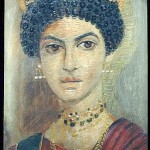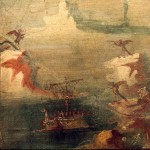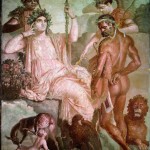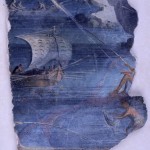Some of ancient Rome’s most beautiful wall paintings are scattered around in museums all over Italy and Europe.
 Now for the first time, 100 of these works (mainly frescoes with a handful of extremely rare portraits on wood) representing the four major styles of Roman painting over the course of 400 years are on display in one place: Rome’s Scuderie del Quirinale museum.
Now for the first time, 100 of these works (mainly frescoes with a handful of extremely rare portraits on wood) representing the four major styles of Roman painting over the course of 400 years are on display in one place: Rome’s Scuderie del Quirinale museum.
The pieces all come from patrician villas discovered in Rome and the Campania region (where Naples, Sorrento and Pompeii are) starting in the 17th century. If you wanted to see them all in their regular domiciles, you’d have to go to Rome, Naples, London, Edinburgh, Paris, Berlin, Moscow, Monaco, Frankfurt and Zurich.
The halls of the exhibition are dim and each of the works has an individually designed back and front lighting system. Some of the piece[s] are so large that the viewer has a feeling that he might just be a guest in the Roman house.
“The rich ancient Romans wanted to live in houses that seemed like the houses of the Gods of Olympus,” La Rocca said[,] “And they wanted to relax in a dream-like atmosphere of satyrs and nymphs.”
One large wall panel contains tiny figures evoking everyday life painted in white on a black background.
The panel, taken from the Villa della Farnesina, a lush house of the late Roman republican period that was discovered in 1879 along the banks of the Tiber and believed to have been the home of Giulia, daughter of the emperor Augustus.
The lighting on the panel aims to reconstruct the effect that flickering candlelight would have had 2,000 years ago, leaving the hosts or guests of the house with the impression that the tiny figures were walking or the tiny ships sailing.
Boy would I love to see that effect. A lot of times modern museum lighting really doesn’t covey the same feeling, especially when the piece being lit originally came from a wall in a house that had relatively few windows to begin with.
(Wee digression: Roman architecture wasn’t big on windows, hence the peristyle garden, which brings natural light to all adjacent rooms without the noise and stench of a street-facing window.
Although Romans did use glass for windows from the early Empire on, they used them for insulation in places like public baths to keep out drafts, so they often weren’t even particularly transparent. In villas, windows were just holes up high in the wall.)
Back on topic, the exhibit opened yesterday and will close on January 17th. The museum will be hosting free companion lectures on Roman painting as well, in an effort to underscore the importance of painting as a medium to the ancients.
The curator points out in this handy Q & A that we forget that the primary medium for Greek and Roman arts was painting, not sculpture. The latter just survives a lot better.
So this exhibit is trying to spotlight how important a cultural aspect it was, how color and paint were everywhere, even though the paintings we have are home decorations rather than major important works like, say, the ancient Roman equivalent of the ceiling of the Sistine Chapel.
Imagine what the REALLY fancy paintings must have been like. I can’t even grasp that, frankly. You can see more of the paintings from the exhibit in this slideshow from an Italian newspaper.
Scuderie del Quirinale museum is worth seeing in and of itself, btw. The Quirinale Palace was originally a summer residence and conference center for the Pope, then the official residence of the King of Italy after reunification, and currently the official residence of the President.
The stables were renovated and made into a museum only 10 years ago, and they don’t look like any stables you might be familiar with. They were built in grand style in the 1700’s.
Oh, and how’s this for a view:



